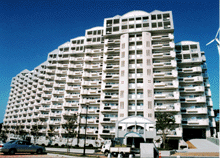
Environment-friendly Apts. in the city of Kitakyushu, Fukuoka Prefecture
Construction of condominiums that use windmills to generate
energy, solar power to heat water, and special facilities to
recycle rainwater and garbage has gotten underway in Japan.
These environment-friendly buildings, which use the forces
of nature to conserve energy and cut down on waste, have
received subsidies and other types of support from the
Ministry of Construction.
Environment-friendly buildings are residential
complexes that not only have the equipment to convert
sunlight, wind, and other such elements into heat or
electricity and rainwater and waste into resources, but also
have tracts of trees and other greenery. The Construction
Ministry began providing subsidies in fiscal 1993, to
encourage the construction of large-scale residential
developments that are environment-friendly. The assistance,
given to developers of condominiums and other housing
complexes that meet certain criteria on environmental
feasibility, cover one-third the cost of the equipment for
making the pavements of roads, parking lots, and other
public areas on the grounds water-permeable and building
parks open to the community.
Japan's first large-scale environment-friendly
building, a 14-floor, 173-unit condominium, recently went up
in the city of Kitakyushu on the southern island of Kyushu.
Each unit has a black flat-plate collector mounted on the
southern balcony to catch the sun's rays. The heat from the
collector serves to compress and heat the gas that flows
past the back of the plate, and the heated gas is used to
boil a tank of water. The tank, meanwhile, is equipped with
a device to regulate water temperature, so even on cloudy or
rainy days the water reportedly stays at a constant 55
degrees Celsius. The families in the condominium say that in
the month they have been there, they have never had to use
gas to heat their bath water.
Wind also serves as an excellent source of energy here.
A windmill has been erected in front of the building, and
the electricity it generates is used as a supplementary
source of energy to light the corridors. Thanks to such
measures, the condominium's residents save 57,000 yen (about
570 dollars) a year per household on their electricity and
gas bills. All units also have a machine on their balconies
to dry kitchen garbage, and the compost that is produced is
used to fertilize plants on the ground. In addition, the
water-permeable parking lots and concrete areas absorb
water, which is stored underground and rechanneled to the
trees and plants on the grounds. More than 30 such
environment-friendly apartment complexes are under
construction or planned, and many people hope that they will
be the wave of the future.
(The above article, edited by Japan Echo Inc., is based on domestic Japanese news sources. It is offered for reference purposes and does not necessarily represent the policy or views of the Japanese Government.)